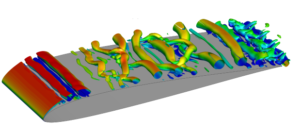Date: Aug 16, 2022
Candidate: Renato Fuzaro Miotto
Advisor:
Prof. Dr. William Roberto Wolf, Instituto de Computação
Abstract:
The onset and evolution of the dynamic stall vortex (DSV) are analyzed by means of large eddy simulations (LES) of an SD7003 airfoil undergoing periodic plunging motion in a transitional Reynolds number flow Re=60,000. Interactions between upstream propagating Kelvin-Helmholtz instabilities and a shear layer formed at the leading edge trigger flow separation. The former appear to be related to acoustic waves scattered at the trailing edge due to initial vortex shedding. Two freestream Mach numbers (M=0.1 and 0.4) are employed to examine the flow differences due to compressibility variations. The existence of a common timing for the acoustic perturbations in both flows suggests a possible Mach number invariance for the birth of the Kelvin-Helmholtz instability. Increasing compressiblity, however, induces earlier spanwise fluctuations, higher flow three-dimensionality and a weaker and more diffuse DSV, which is formed further downstream of the leading edge and has lower residency time. In order to better characterize the onset of the DSV, two empirical criteria are assessed: the leading edge suction parameter (LESP) and the chord-normal shear layer height. Results demonstrate a higher robustness of the latter with respect to Mach number variations. Modal decomposition, performed with both the classical dynamic mode decomposition (DMD) and its multi-resolution variant (mrDMD), highlights key trends and demonstrates the capacity of the mrDMD to extract physically meaningful flow structures related to the stall onset. Such detailed characterization of the shear layer can be used for a systematic exploration of flow control strategies for unsteady airfoils. In the present work, we also perform LES to investigate the pitch-plunge equivalence of an SD7003 airfoil undergoing constant ramp motions at Reynolds number Re=60,000. The equivalence is constructed based on the geometric effective angle of attack according to the quasi-steady thin-airfoil theory. Two rates of descent (or pitch up) are analyzed for different Mach numbers in order to investigate the effects of compressibility on the evolution of the DSV. During the onset of the DSV and its transport along the airfoil surface, remarkable similarities are found between pitch and plunge in terms of flow topology, aerodynamic loads and signatures of wall pressure and friction coefficients. However, these flow similarities cease at high-load conditions as the DSV becomes more susceptible to the peculiarities of the airfoil motion, manifested here by different trailing-edge vortices (TEVs). Employing a correction for the rotation-induced apparent camber effect present in the pitching case, which results from the quasi-steady thin-airfoil theory, improves the agreement between pitch and plunge. However, it is not sufficient to assimilate their disparate trailing-edge systems. Results also demonstrate that the limit angle at which pitch-plunge equivalence remains valid decreases for higher Mach numbers. Finally, we propose a framework whereby numerical simulation data is leveraged to extract relevant information from experimental visualizations. To this end, the convolutional block of pre-trained InceptionV3 network is used to build a regression model that links the map of pressure coefficient to aerodynamic coefficients of the airfoil. The resulting convolutional neural network (CNN) correctly interprets the attributes present in the input flow image. Aspects of the generalization of the model are discussed and the performance of the velocity field as input is assessed. Results show that pressure is preferable to velocity when it comes to building our regression model. Nonetheless, we demonstrate that the velocity can be used to synthesize any corresponding physical quantity through an image-to-image translation approach. Here, the mapping between velocity and pressure coefficient field is used as example.


